
For some reason, when it comes to noses, people struggle. Perhaps this is because a nose is an irregular form - it's not a simple shape like a circle and it's not quite a triangle either. It's not as hard to draw realistic noses as one may think. It's actually rather simple. All it takes is four lines and then the rest is adding value. Don't fall into the trap of thinking that drawing noses is difficult.

Many people have incorrectly learned how to draw a nose. When you learn something incorrectly, it is even harder to learn how to do it correctly. This is true of anything, not just drawing. Many of us have been taught to draw that "L" shape or perhaps the "w" shape with an extra "u" when we draw a nose.

Drawing noses this way is so far from drawing them realistically. If you are going for a cartoon nose, then that may be a good direction to go. But for a realistic nose, you must really observe your subject.
Here's a look at the finished drawing from the video above...

You must closely observe your subject when you draw anything. Drawing noses realistically involves studying the values. The values are what gives us the impression and illusion of the form. Make sure that you include a full range of value when you draw a nose.
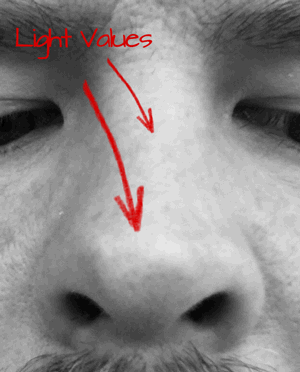 Drawing lines will help to establish the shape of the nose, but it's the values that will lead to the illusion of form that you probably want in you drawing.
Drawing lines will help to establish the shape of the nose, but it's the values that will lead to the illusion of form that you probably want in you drawing.
Your drawing must include the darkest shades and the lightest tints and the grays in between. Keep in mind that no two noses will be the same. Observation is really the biggest secret when it comes to drawing.
Try to pinpoint the locations on the nose where these values are located and notice the subtle changes that happen in the highlights (light values), midtones (middle values), and the shadows (dark values).
We'll explore several different options for drawing a nose in this lesson and look at a number of examples. It makes sense to look at drawing the nose from a frontal view first. This way, we can better understand the structure and what we should look for and include in our drawing.
Before drawing any lines, we'll first examine the form of the nose and how we can simplify it into a system of planes.
A nose can be simplified into basic planes. You may think of a chiseled form to better understand the planes. Remove the curvature of the nose from your mind and simplify the form into rigid flat planes.
Recognizing the planes not only helps us to draw the form, but it also helps us to understand where we should add shading. It is the shading, or value range, that ultimately leads to the illusion of a 3-Dimensional form.
In the image below, you'll see an example of a nose from a frontal view, simplified into basic planes. As the form changes direction in space, it creates a new plane. There are three planes designated for the top, three for the middle, and three underneath.
In the beginning stages of the drawing, you may find it helpful to draw these planes first. This way, you can focus on the form before drawing any of the lines for the nostrils or adding tone.
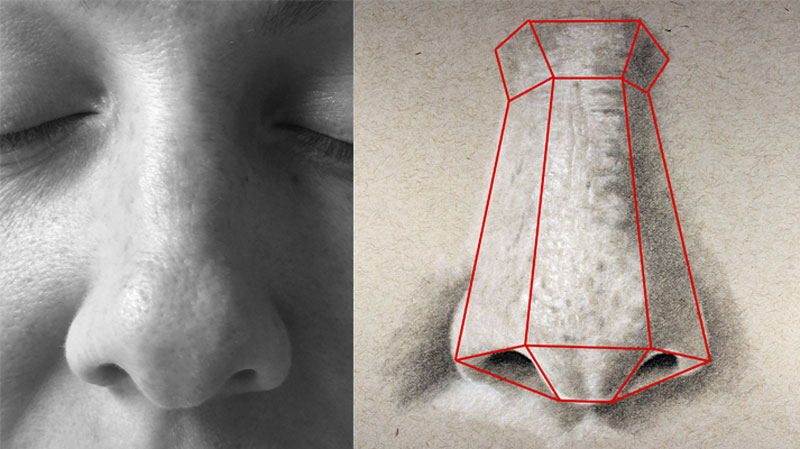
When most of us learn to draw, we start by drawing lines. We use lines to define the boundaries of objects and to add details. So it's only natural to look for lines when we draw any object.
A nose, however, doesn't feature strongly defined lines. Our mind simplifies changes in value or contrast into "perceived lines". For a nose, these areas include the shapes of the nostrils and the outer edges of the nostrils. This is simply because we notice strong contrast in value in these locations. In reality, the value changes gradually, instead of creating a defined line.
We can use the planes of the nose to position the perceived lines that we see. Using the outer boundaries of the planes, we can mark the outer edges of the nostrils. We can also use the bottom planes to position the shapes of the nostrils.
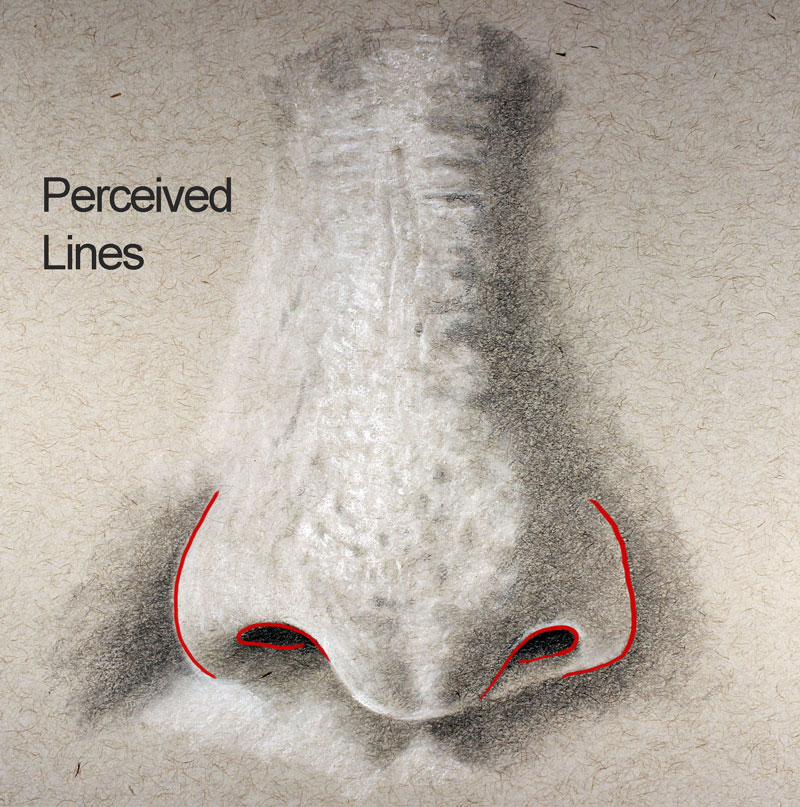
Understanding the planes of the nose helps us to draw the basic structure and position the "perceived lines", but the planes also perform another important task. We can use these planes to determine the locations of value.
In this example, the light source originates from the upper left corner. This produces lighter values on the left side of the nose, closer to the light source. This means that the plane that faces the light source will be lighter. Darker values are found on the opposite plane on the right side of the nose.
Since our light source is also coming from above, you'll notice that the planes underneath the nose are also darker. There is, however, a slight highlight in areas here.
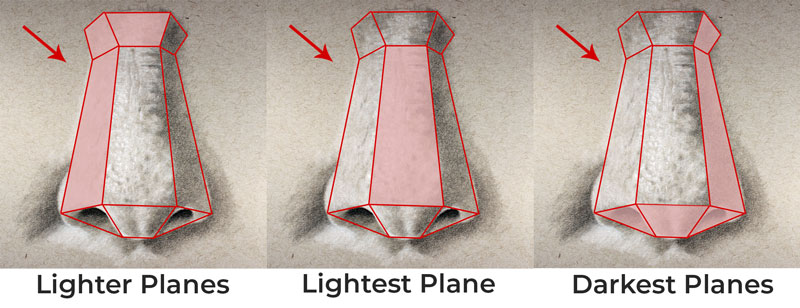
The bridge of the nose protrudes outward. As a general rule, most objects that protrude receive more light and are usually lighter in tone. They also usually produce a shadow underneath. In this case, the bridge of the nose is receiving the strongest light. The values developed here should be slightly lighter than the values found on the left plane of the nose.
Now that we have a basic understanding of the locations of value and how dark or light they should be, we can begin the process of shading. However, the term "shading" is somewhat confusing. It suggests that we are only addressing the dark values, or shades. In reality, the process of "shading" is the process of developing a full range of value. This means we should consider both the tints (light values) and the shades (dark values) together.
If you're working on white paper, you may choose to leave the areas of highlight "open" or address them with a very light application of graphite. If you are working on toned paper, as we see with this drawing, you can add the highlights with a light drawing medium. In this case, a white charcoal pencil is used.
Prior to adding the highlights, we'll begin with a light application of graphite using an H graphite pencil. This gives us a starting point.
A blending stump is then applied to smooth the texture and work the graphite material into the tooth of the paper.
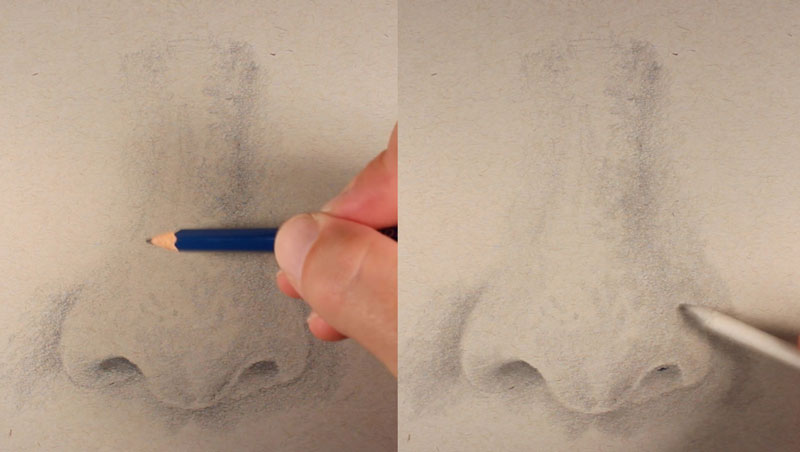
Once the locations of darker value are established with a light application, we can define the highlights with a white charcoal pencil. Again, this application is gently blended with a blending stump.
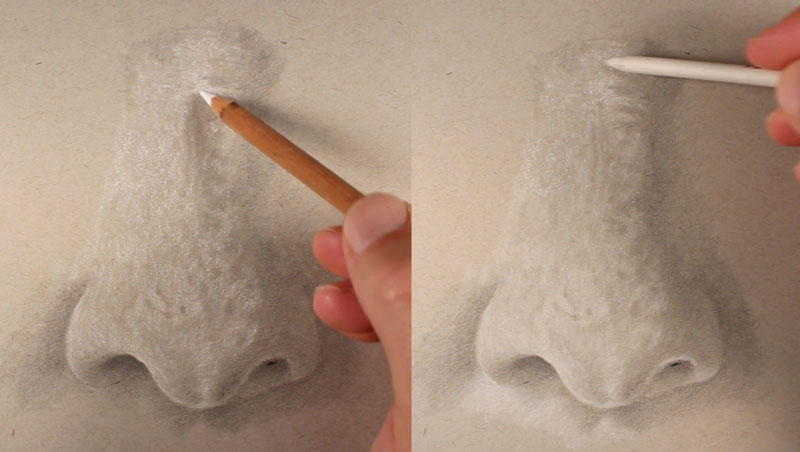
Then it's a matter of gradually darkening the shades to increase contrast. A softer and darker, graphite pencil is used the darken the areas within the nostrils and the shadows that exist on the right side and underneath the nose.
We can also continue to add highlights, if necessary, to extend the range of value and the contrast. As applications are made, they are gently blended with a blending stump. You'll notice that as the value is developed the texture of the nose is also developed.
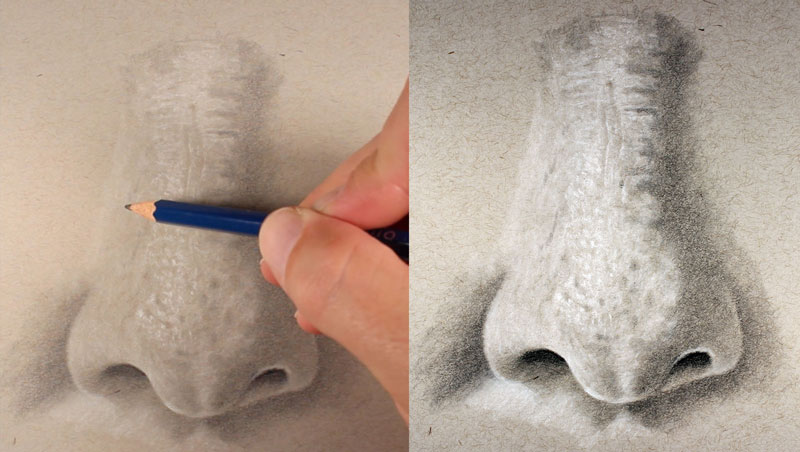
A more in-depth video of this lesson, along with an illustrated ebook can be found in the course, "Portrait Drawing the Smart Way".
Here's the process that we outlined above, simplified and broken down into a step by step approach...
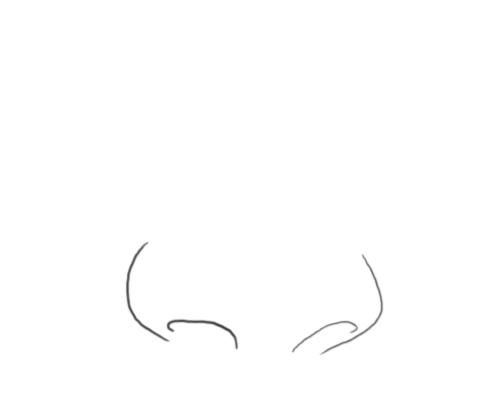
Begin your drawing of a nose by drawing four lines. Two lines are drawn for each nostril and then two more for each edge of the nose.
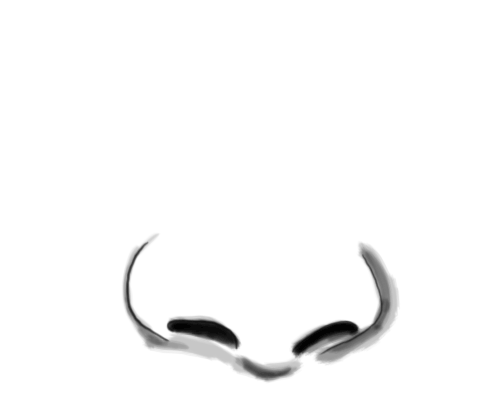
Now you can begin to add darker values where the nose is shaded. Start with the areas that are the darkest and slowly get darker with your pencil.
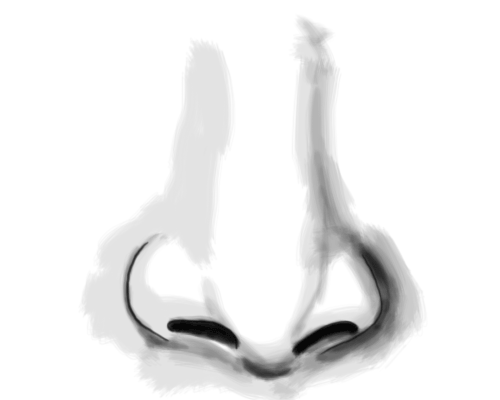
Continue with adding shading to the nose to create the illusion of a light source. Be careful not add more lines. Instead, just concentrate on light and dark areas.
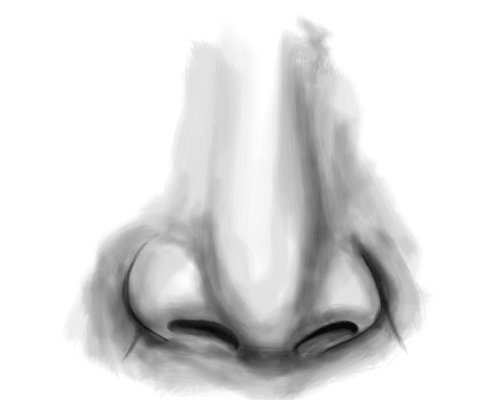
The more value that you add, the more your nose will look realistic. Areas of the nose that are light will look like they protrude, while areas that are dark will look like they go back in space.
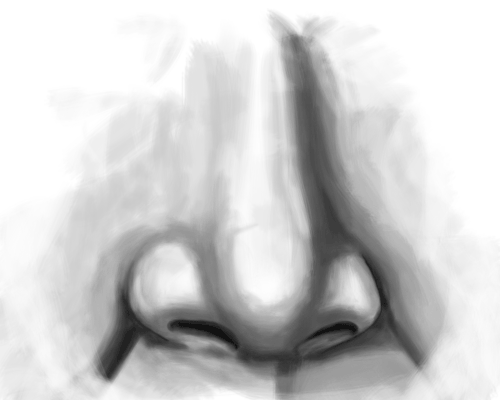
As long as you keep looking for the dark and light areas on the nose, and draw what you see, your nose will look realistic.
Once you have a basic idea of how to draw a nose from a frontal view, it's time to look at drawing a nose from the side.
There's more than one way to draw a nose. In fact, since every nose is different, there are virtually unlimited ways to draw a nose. Next, we'll take a look at drawing a nose from a side view. This is usually referred to as a profile view.
As we did with the frontal view, we'll first locate basic shapes. When drawing a nose from this angle, it may be difficult to identify the planes, so basic shapes will suffice.
Look for changes in spacial direction to find the most basic shapes. As we see below, the upper portion of the nose can be simplified with two shapes. The lower portion of the nose is simplified into an organic shape that extends downward from the top two shapes.
We'll draw these basic shapes first to define the form of the nose.
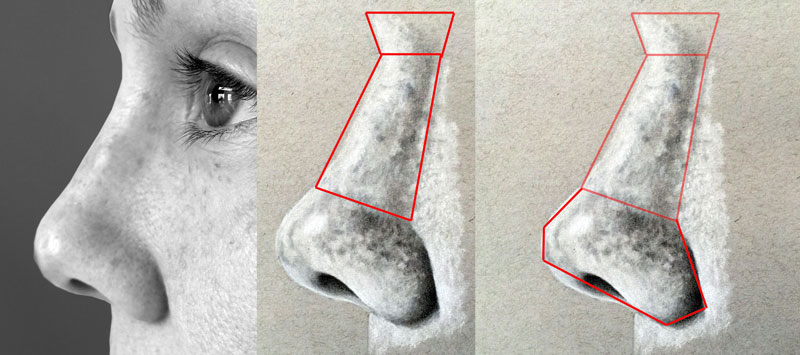
Next, we can draw the perceived lines that we discussed before along with the outer contours. After these lines are in place, we can begin the process of developing the value and texture.
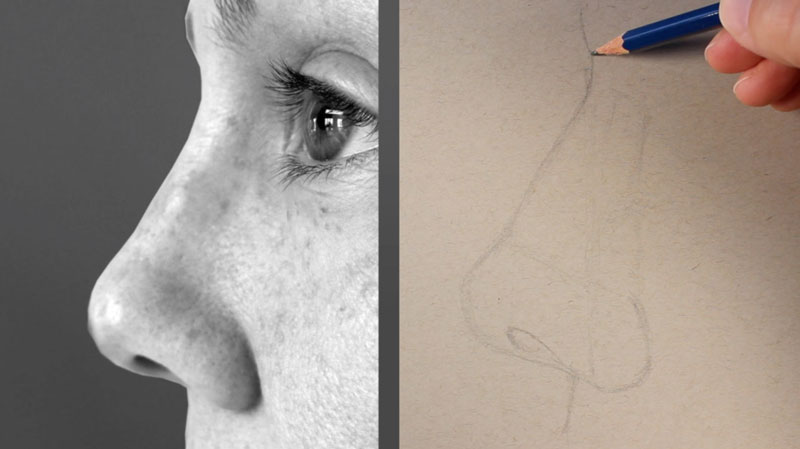
As we develop the value range, we'll consider the light source. As we see in this example, the light source originates from the left. This creates shapes of different tones on the nose. The bridge of the nose receives the most light. The cheeks are also receiving a fair amount of light. Curiously, the bottom of one of the nostrils is also lighter. This is the result of light reflecting back up from below, producing an area of reflected highlight.
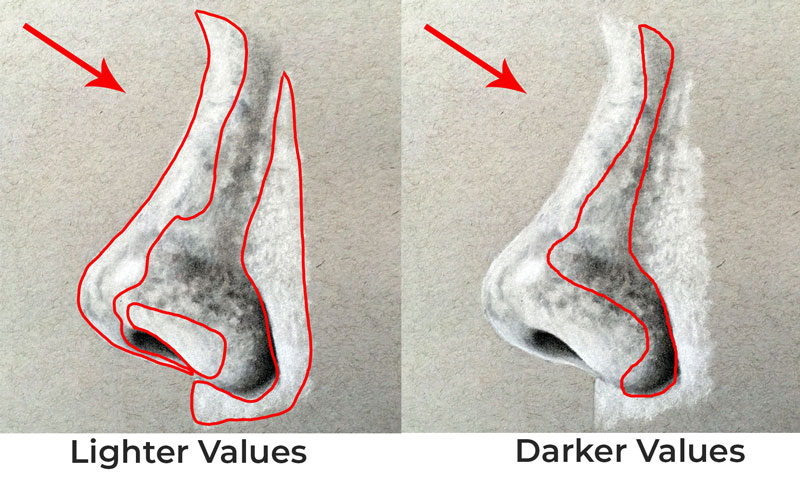
As we did before, we'll start adding light graphite applications to establish the shapes of the darkest value. These applications are blended with a blending stump to create a smooth texture.
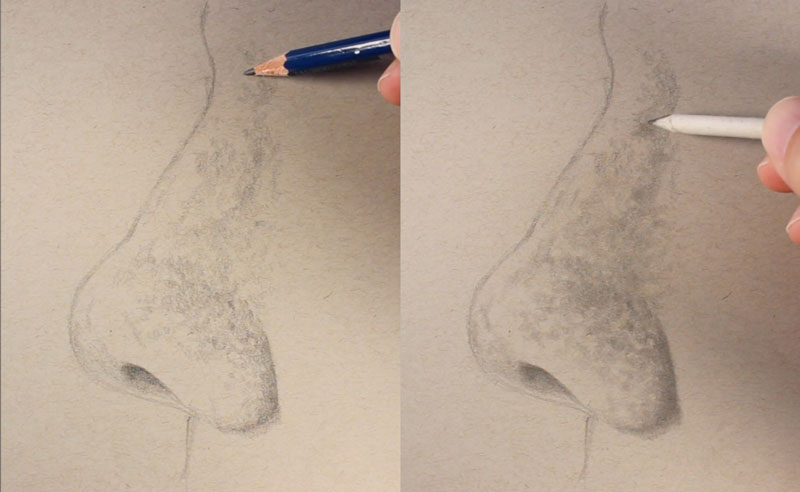
Then we can add the highlights. In this example, we're again working on a toned drawing surface. This allows us to add the highlights with a white medium like white charcoal. After the initial highlights are added, we can blend them as well.
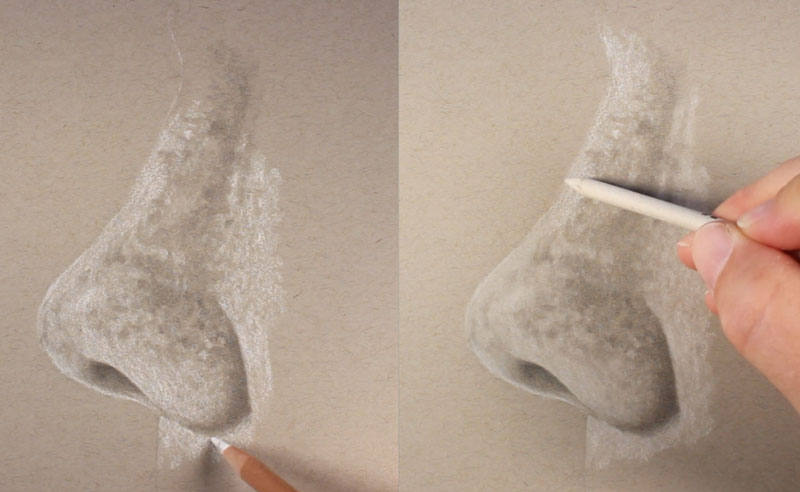
Now we simply need to darken the value to create a full range and increase the contrast in the drawing. Softer graphite pencils are applied and blended to gradually "push" the tonal range.
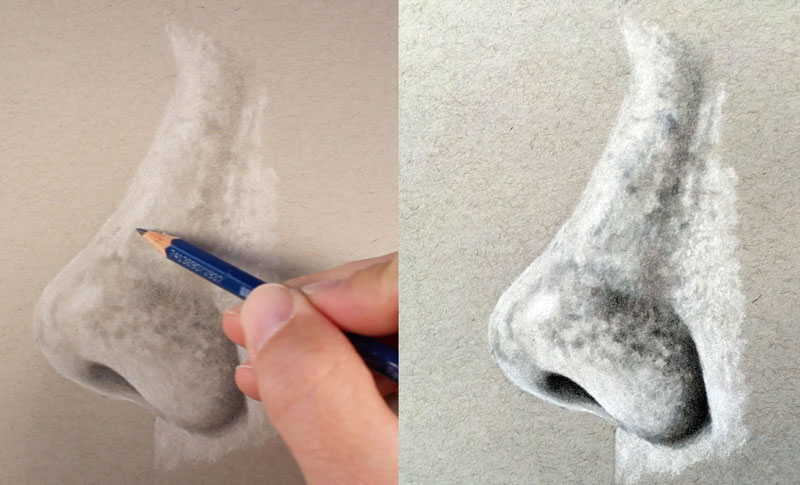
For more on this demonstration see the course, "Portrait Drawing the Smart Way".
Now that you've got the basic concept down, it's time to take your skills to an actual subject. This might be a nose that you draw from life, or one that you draw from a photo reference. Either way, the process of drawing will heavily depend on observation.
When you are observing a nose, look for the "planes" - or simple geometric shapes that represent how the nose exists in space.
Take the following drawing for example...
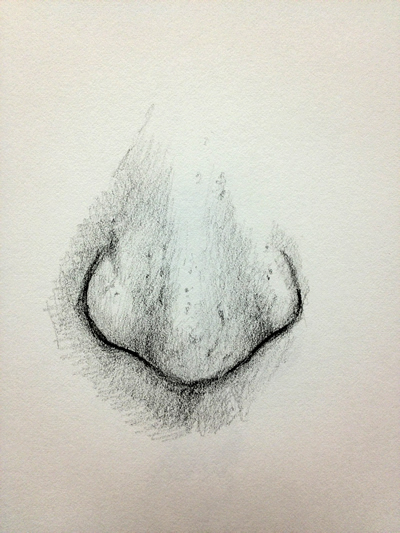
Now look at the planes that can be easily drawn to create the form of the nose...
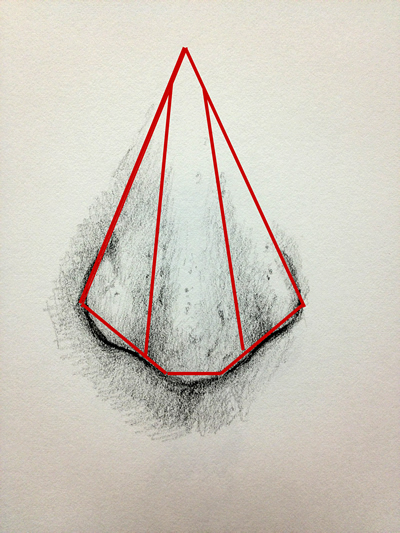
Here's another look at the nose from the side view.
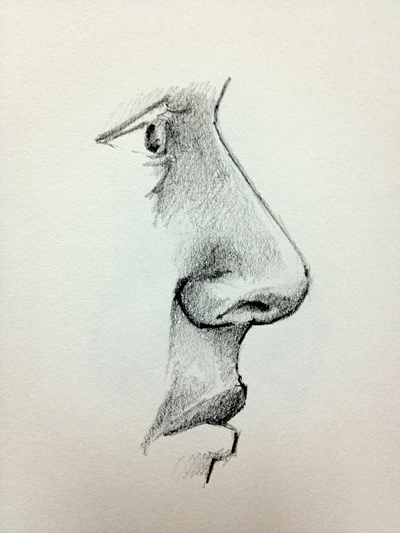
Here is the same drawing with the planes highlighted...
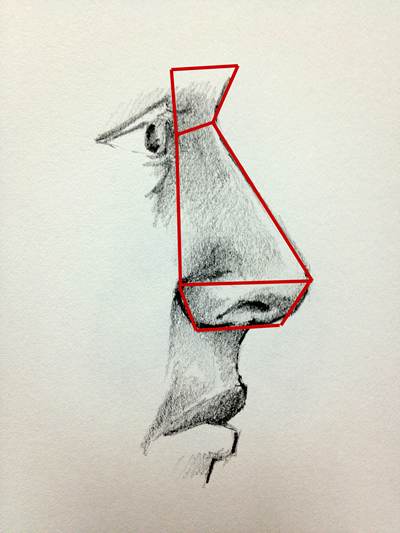
Certain angles of the nose can present challenges...
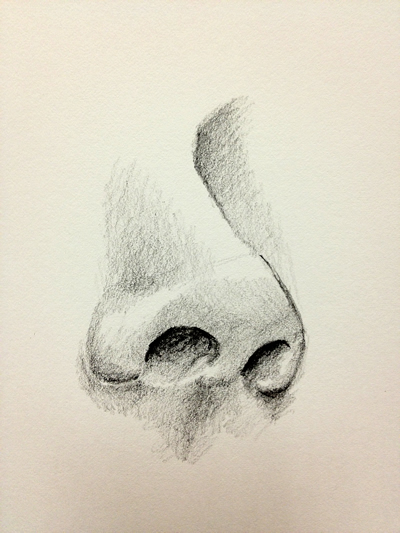
But here again, if you break the nose down into geometric planes, this angle is made easier to draw...
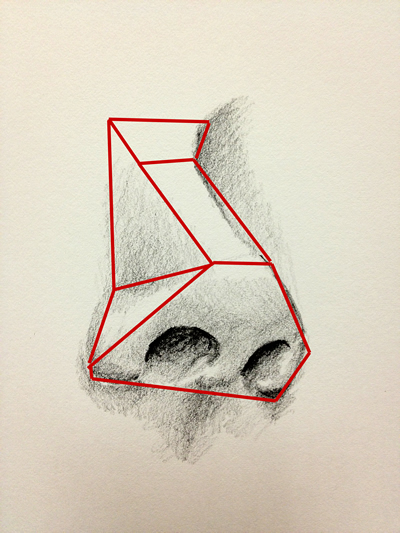
Now that we've had at look at several different noses, you are well equipped to draw your own. Just remember the steps we took...
As always, take your time and be patient. With practice, you'll master the art of drawing noses.